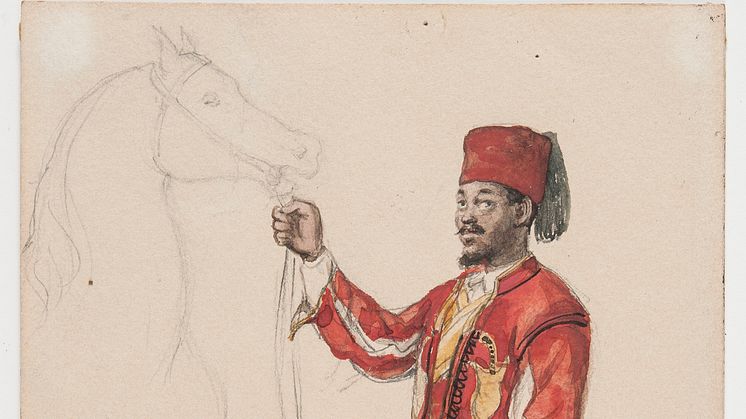
Press release -
New acquisition: Portrait of John Panzio Tockson by Fritz von Dardel
Nationalmuseum has acquired a portrait of John Panzio Tockson by the artist and courtier Fritz von Dardel. Unlike many of Dardel’s other, more caricatured and stereotypical portrayals of King Karl XV’s valet, this pen-and-watercolour drawing is an unusually vivid depiction of Tockson as an individual. In the portrait he is wearing his distinctive red, oriental-style costume with a fez.
As well as pursuing a military and civil service career, Fritz von Dardel (1817–1901) had the opportunity around 1840 to train as an artist in Paris under Léon Cogniet and Eugène Lami.On his return to Sweden, the urbane and multitalented Dardel soon became adjutant and close confidant to the crown prince, later King Karl XV. In the field of art in particular, Dardel played a major role in advising the king on purchases and expanding the Nationalmuseum collection.
From his teacher Lami, Dardel had acquired a talent for capturing the glamorous social life of his time in deftly executed watercolours. He is chiefly associated with gentle caricatures, known as charged portraits, of the leading figures of the day, whom he encountered in his role as cabinet chamberlain. Dardel also produced paintings of various scenes and events he had witnessed, which are interesting from a topographical and a cultural history perspective.
Alongside his recollections in image form, Dardel wrote a series of memoirs. One figure of whom Dardel’s writings offer the merest glimpses, but who was drawn by him on numerous occasions, was John Panzio Tockson or Toxon (1838–88), valet to King Karl XV. His background is shrouded in mystery, but in all probability he was born in Africa, possibly in Madagascar. Rumour has it that Tockson was sold into slavery but managed to escape and make his way to Gothenburg. He is believed to have first entered the service of a Major Wästfelt and to have then worked as a servant to the Älvsborg Regiment before arriving at the court of Karl XV around 1860.
Dardel mentions Tockson for the first time in June 1861 in connection with Midsummer celebrations at Ulriksdal.Tockson’s many duties included stuffing and cleaning the king’s pipes, which earned him the nickname of “Pipe Cleaner”. Surviving records confirm this, but Tockson had many more responsibilities. He served as the king’s personal valet and looked after the monarch’s dogs and horse. It is in the role of stable valet that we see Tockson in Dardel’s portrait. He is wearing one of his distinctive costumes with a red fez, bolero-style jacket and knee breeches.In his hands, he holds the reins of the fine horse alluded to at left in the drawing.Tockson was in the habit of escorting Karl XV on horseback when the king rode out to Djurgården on May Day, as described by August Strindberg in his social satire The New Kingdom. On one such occasion, Tockson accidentally landed in the ditch, after which he ceased to be a member of the royal entourage for the May Day ride. However, he did not leave court altogether until the death of Karl XV, after which he received a modest pension. John Panzio Tockson married in 1870, had two children, and supported himself through a series of odd jobs in Stockholm until his death.
Alongside Augusta Åkerlöf’s portrait of Tockson, which has long been part of the Swedish National Portrait Gallery, Fritz von Dardel’s unusually penetrating portrayal adds a new dimension to the image of a court servant of African heritage, the last person in Sweden to hold the title of “Court Moor”.
Nationalmuseum’s purchase of this work has been made possible by a generous donation from the Axel Hirsch Foundation.Nationalmuseum has no budget of its own for new acquisitions, but relies on gifting and financial support from private funds and foundations to enhance its collections of fine art and craft.
Press contact
Magnus Olausson, Head of Collections and Research, magnus.olausson@nationamuseum.se,
+ 46 8 5195 4371
Hanna Tottmar, Press Officer, press@nationalmuseum.se, +46 767 23 46 32
Categories
Nationalmuseum is Sweden’s premier museum of art and design. The collections comprise older paintings, sculpture, drawings and graphic art, and applied art and design up to the present day. The museum building is currently under renovation and scheduled to open again in 2018. In the meantime, the museum will continue its activities through collaborations both in Sweden and abroad as well as temporary exhibitions at the Royal Swedish Academy of Fine Arts, Fredsgatan 12 and Nationalmuseum Design at Kulturhuset Stadsteatern in Stockholm. Nationalmuseum has partnerships with Svenska Dagbladet and the Grand Hôtel Stockholm, and acknowledges the support of FCB Fältman & Malmén.

